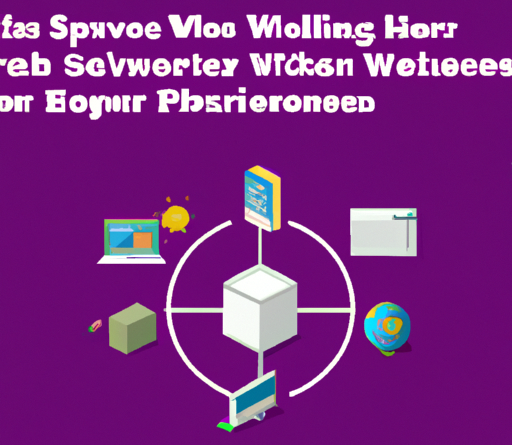In this article, you will discover the ins and outs of a mail server. Ever wondered how your emails land in your inbox? Well, it’s all thanks to the mail server. Acting as the digital postman, a mail server diligently works behind the scenes to ensure smooth delivery of your messages. From sending to receiving, let’s unravel the mysteries of this essential component of modern communication.
Defining a Mail Server
Explanation of mail server
A mail server, also known as a mail transfer agent (MTA), is a computer program or software application that enables the sending, receiving, and storing of emails. It acts as a central hub for the delivery of electronic messages between users and provides the necessary protocols and infrastructure to facilitate efficient email communication.
Purpose of a mail server
The main purpose of a mail server is to ensure the smooth and reliable transmission of emails from one user to another. It serves as the intermediary between the sender and the recipient, handling the processes of sending, delivering, and storing emails. Additionally, mail servers provide a range of features such as email management, security measures, and user authentication to enhance the overall email experience.
Components of a Mail Server
Mail Transfer Agent (MTA)
The Mail Transfer Agent (MTA) is a crucial component of a mail server responsible for the transmission of emails across different networks. It is responsible for routing the emails from the sender’s MTA to the recipient’s MTA using standardized protocols such as SMTP (Simple Mail Transfer Protocol). The MTA determines the most efficient path for email delivery and ensures that the email reaches the intended recipient’s mailbox.
Mail Delivery Agent (MDA)
The Mail Delivery Agent (MDA) handles the final process of delivering the email to the recipient’s mailbox. Once the email reaches the recipient’s MTA, the MDA takes over and stores the email in the appropriate mailbox directory or folder. This component is responsible for managing the storage, retrieval, and organization of emails within the mail server.
Mail User Agent (MUA)
The Mail User Agent (MUA), also known as an email client or email reader, is the software or program used by users to interact with their mail server. It provides a graphical interface or command-line interface for users to compose, send, receive, and manage their emails. Popular examples of MUA include Microsoft Outlook, Gmail, and Mozilla Thunderbird.

Types of Mail Servers
SMTP Servers
SMTP (Simple Mail Transfer Protocol) servers are specifically designed for sending emails. They handle the outgoing emails from the sender’s MTA and ensure their successful delivery to the recipient’s MTA. SMTP servers use a set of rules and protocols to initiate the email transfer process, including establishing a connection, verifying addresses, and routing the email to the recipient. They play a crucial role in enabling effective email communication.
POP3 Servers
POP3 (Post Office Protocol 3) servers are responsible for the retrieval of emails from a mail server to the user’s device. When a user wants to check their email, the POP3 server allows them to download their messages from the mail server onto their computer or mobile device. It typically deletes the email from the server after downloading, but there are options to keep a copy on the server for future access across multiple devices.
IMAP Servers
IMAP (Internet Message Access Protocol) servers provide a different approach to email retrieval compared to POP3 servers. With IMAP, emails are not downloaded to the user’s device but are stored on the mail server itself. The user interacts with the emails directly on the server, allowing access from multiple devices while keeping the email data centralized. IMAP servers provide advanced features such as synchronizing folders, searching emails, and managing email flags.
Exchange Servers
Exchange servers, developed by Microsoft, are widely used in business environments that rely heavily on email communication. They combine multiple components, including a mail server, messaging platform, and collaborative tools. Exchange servers incorporate features such as calendar sharing, address book synchronization, task management, and resource booking. They offer a comprehensive solution for businesses seeking efficient email communication and collaboration.
How Does a Mail Server Work?
Sending an Email
When you send an email, the process begins with your Mail User Agent (MUA). You compose the email, enter the recipient’s email address, and click send. Your MUA then communicates with your Mail Transfer Agent (MTA) to initiate the email transmission.
The MTA, acting as the sender’s representative, establishes a connection with the recipient’s MTA using SMTP (Simple Mail Transfer Protocol). It validates the recipient’s email address and relays the email to the recipient’s server. The recipient’s MTA receives the email and processes it for delivery to the recipient’s mailbox.
Delivering an Email
Once the recipient’s MTA receives the email, it hands off the email to the Mail Delivery Agent (MDA) for further processing. The MDA determines the appropriate mailbox or folder to store the email and saves it in the recipient’s mailbox directory.
The recipient can now access the email through their Mail User Agent (MUA) by connecting to their mail server. The MUA retrieves the email from the mailbox and presents it to the recipient for reading, replying, or further management.
Storing and Retrieving Emails
Mail servers are responsible for storing and organizing emails for efficient retrieval. When an email is received, the MDA stores it in the recipient’s mailbox. The mailbox can be organized into folders, allowing users to categorize and manage their emails effectively.
When users want to retrieve their emails, they connect to their mail server using their MUA. The MUA communicates with the mail server, either through POP3 or IMAP protocols, and retrieves the requested emails. The server responds by sending the emails back to the MUA, allowing users to view and manage their email messages.

Protocols Used by Mail Servers
Simple Mail Transfer Protocol (SMTP)
SMTP, or Simple Mail Transfer Protocol, is a widely used protocol for email transmission. It enables the exchange of emails between mail servers, allowing for reliable and efficient delivery. SMTP defines rules and procedures for establishing connections, verifying email addresses, and routing emails to the appropriate recipient’s server. It ensures that emails are sent and received securely across different networks.
Post Office Protocol 3 (POP3)
POP3, or Post Office Protocol 3, is a protocol used by mail servers for email retrieval. It allows users to download their emails from the mail server to their device. POP3 typically deletes the emails from the server after downloading, although there are options to keep a copy on the server. It is commonly used when users want to access their emails offline or prefer to store their emails locally.
Internet Message Access Protocol (IMAP)
IMAP, or Internet Message Access Protocol, is another protocol used for email retrieval. Unlike POP3, IMAP does not download the emails to the user’s device but keeps them stored on the mail server. Users can access and interact with their emails directly on the server, allowing for synchronization across multiple devices. IMAP supports advanced features such as folder synchronization, searching emails, and managing email flags.
Security Measures for Mail Servers
Encryption
Encryption plays a crucial role in ensuring the security and privacy of email communication. Mail servers can utilize encryption protocols such as SSL (Secure Sockets Layer) or TLS (Transport Layer Security) to encrypt the email transmission between the sender and recipient. This prevents unauthorized access to the email content and minimizes the risk of intercepted or tampered emails.
Authentication
Authentication mechanisms are employed by mail servers to verify the identity of both the sender and recipient. Sender authentication protocols, such as SPF (Sender Policy Framework) and DKIM (DomainKeys Identified Mail), help validate that the sender is legitimate and prevent email spoofing. Similarly, user authentication methods, such as username and password combinations, ensure that only authorized users can access and manipulate their emails.
Spam filtering
Spam filtering is an essential security measure for mail servers. It helps identify and block unsolicited and potentially harmful emails, commonly known as spam. Mail servers employ various techniques, including content analysis, blacklisting, and reputation-based filtering, to detect and filter out spam emails. This improves the overall email experience by reducing unwanted and potentially dangerous content from reaching users’ inboxes.

Understanding Email Delivery Problems
Bounced Emails
Bounced emails occur when an email is returned to the sender due to delivery failure. This could happen due to various reasons, such as an invalid email address, full inbox, or server-side issues. Bounced emails provide important feedback to the sender, indicating delivery problems that need to be addressed. By understanding the bounce codes and messages associated with bounced emails, senders can troubleshoot and resolve delivery issues.
Spam Traps
Spam traps are email addresses specifically created to catch and identify spammers. These addresses are not actively used by real users but are monitored by email service providers and anti-spam organizations. If an email is sent to a spam trap address, it indicates that the sender may be engaging in spamming activities. Mail servers must be vigilant in detecting and preventing emails from being sent to spam traps to maintain a good sender reputation and ensure email deliverability.
Email Blocking and Filtering
Different mail servers and email service providers implement various blocking and filtering mechanisms to protect users from spam, malicious content, and unwanted emails. These mechanisms may include blacklisting certain IP addresses, domains, or filtering based on content analysis. While these measures help improve the email experience and security, legitimate senders should ensure that their emails comply with best practices and avoid triggering filters that may result in lowered deliverability rates.
Choosing the Right Mail Server
Considerations when selecting a mail server
When choosing a mail server, there are several factors to consider. These include the scalability of the server to meet your organization’s email needs, compatibility with existing systems and applications, security features, reliability and uptime, ease of administration, and cost. It is important to assess your organization’s requirements and evaluate different mail server options to find the one that best suits your needs.
Features to look out for
Mail servers can offer various features that enhance the email experience and productivity. These may include robust spam filtering, support for encryption protocols, integration with other communication and collaboration tools, comprehensive user management and administration capabilities, customizable mailbox storage options, and reliable backup and disaster recovery mechanisms. Assessing your organization’s specific requirements will help determine the necessary features to look for in a mail server.

Setting Up a Mail Server
Necessary hardware and software
Setting up a mail server requires appropriate hardware and software components. The hardware typically includes a dedicated server or a virtual private server (VPS) with sufficient processing power, storage capacity, and network connectivity. Additionally, software components such as an operating system, an MTA (Mail Transfer Agent) software, and an MDA (Mail Delivery Agent) software are required to configure and run the mail server effectively.
Configuration steps
Configuring a mail server involves several steps to ensure its proper functioning. These steps include installing the necessary software components, setting up DNS records to map domain names to the mail server’s IP address, configuring the MTA with appropriate routing and security settings, and configuring user accounts and access permissions. It is crucial to follow the documentation and guides provided by the mail server software to ensure accurate configuration.
Testing the setup
After the mail server is configured, it is essential to test its functionality to ensure that emails are sent, delivered, and retrieved correctly. This can be done by sending test emails between different email accounts, checking for successful delivery and proper retrieval. Testing should also include verifying the functionality of security measures, such as encryption and spam filtering, to ensure they are working as intended. Any issues identified during testing should be addressed promptly to ensure a smooth email experience.
Does Your Business Need Its Own Mail Server?
Advantages of having a private mail server
Having a private mail server offers several advantages for businesses. It provides full control over email management, allowing organizations to tailor the server’s features, security measures, and storage options to their specific needs. It can also enhance privacy and data security, particularly for businesses handling sensitive information. A private mail server can offer better customization and integration options with other business applications, increasing overall efficiency and productivity.
Disadvantages of a private mail server
Running a private mail server also comes with certain disadvantages. It requires significant technical expertise and resources to set up, configure, and maintain the server effectively. It can be time-consuming and costly to ensure continuous and reliable operation, particularly for small businesses with limited IT resources. Additionally, maintaining deliverability and reputation may be more challenging compared to using reputable email service providers that already have established network infrastructure and monitoring systems.
Determining if your business requires a private mail server
Whether your business requires a private mail server depends on various factors. Considerations include the size and complexity of your organization, the need for greater control and customization, regulatory compliance requirements, data security concerns, and the availability of IT resources. Small businesses or organizations with limited IT capabilities may find it more practical and cost-effective to rely on reputable email service providers. Larger businesses with specific needs and resources may benefit from the advantages of a private mail server.
In conclusion, a mail server is a crucial component of modern communication infrastructure. It enables the seamless sending, delivering, and storing of emails, connecting users across different networks. Understanding the different components, types, and protocols used by mail servers, as well as the security measures and common issues they encounter, is essential for efficient email communication. Whether to choose a private mail server or rely on email service providers depends on the specific needs and resources of businesses. With the right mail server in place, businesses can benefit from improved productivity, security, and control over their email communication.







